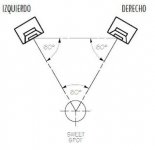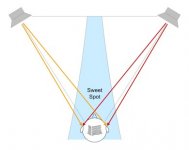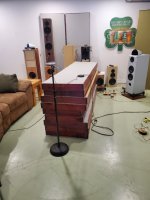Also assembling good sounding system from accidental purchases rarely works and I should know being on purchase Merry go Round for decades. It just drains the resources and leads to looking interest in music itself.
Audio stores are not entirely run by crooks. Some of the dealers are genuinely interested in helping people and know what they are talking about.
Audio stores are not entirely run by crooks. Some of the dealers are genuinely interested in helping people and know what they are talking about.
Cost isn't really a big issue. I'm willing to spend a decent amount for a good solution as I indicated in the first post. Overall speaker size is more of an issue for me than cost.It seems to me that:
1. The Piccolos already meet your mid and high frequency needs, Therefore you want to retain the present mid and hf drivers in substantially the same configuration. So you have the answer to your original question: neither replacing the amplifier nor the speakers is an appropriate solution.
2. So you need to rephrase the question to something like: "What are the cost/benefits of augmenting or replacing the bass performance of the mid/bass driver?" I think that it may be best to look at this as an iterative process. I.e. You should ask:
a) "What action will achieve the biggest improvement with the least cost in time, money etc..."
b) "Are you satisfied with the results?
i. If No, go to a) above.
ii. If Yes, job done. Sit down and enjoy the sound. 🙂
If your priority is the size of the speakers, there is an interesting PDF file on the Meniscus site called "Piccolo write-up". In it, Jeff Bagby mentions a vented variant of the Piccolo design...speaker size is more of an issue for me than cost.
Yeah. I've read it many times. That write-up is the main reason I built the Piccolos to begin with. I built them sealed to begin with, but now will probably add the vent tube. Easy to do since backs at attached with screws rather than glue exactly for this purpose.If your priority is the size of the speakers, there is an interesting PDF file on the Meniscus site called "Piccolo write-up". In it, Jeff Bagby mentions a vented variant of the Piccolo design...
Music sounds better when you sit down and listen instead of running in circles.
A week ago you seemingly drew a post at random and decided the lucky winner was somebody who suggested a bigger woofer. You seemed certain this was the fix.
Now you’re convinced porting your speakers is the solution despite not mentioning your speakers were acoustic suspension in the first place.
Please understand everyone suggesting fixes here is trying to help. For instance, it would make no sense to port your existing cabinets if you think you might want to later add a woofer (per the Bagby write-up I linked to). Unless of course you’re going to create a new rear panel with a port and hold on to the one without.
I don’t know if you’re thinking about mid-bass suckout related to floor bounce but a properly implemented three-way (such as the Bagby article lays a path for) can help eliminate that. Simply porting your existing speakers is just going to increase the LF extension, add a second impedance peak to the woofer and increase group delay. It will do nothing to combat floor bounce.
A week ago you seemingly drew a post at random and decided the lucky winner was somebody who suggested a bigger woofer. You seemed certain this was the fix.
Now you’re convinced porting your speakers is the solution despite not mentioning your speakers were acoustic suspension in the first place.
Please understand everyone suggesting fixes here is trying to help. For instance, it would make no sense to port your existing cabinets if you think you might want to later add a woofer (per the Bagby write-up I linked to). Unless of course you’re going to create a new rear panel with a port and hold on to the one without.
I don’t know if you’re thinking about mid-bass suckout related to floor bounce but a properly implemented three-way (such as the Bagby article lays a path for) can help eliminate that. Simply porting your existing speakers is just going to increase the LF extension, add a second impedance peak to the woofer and increase group delay. It will do nothing to combat floor bounce.
Last edited:
As I already posted previously, that's my plan. No cost at all. Just need to find the time to get into my shop and do it.... Unless of course you’re going to create a new rear panel with a port and hold on to the one without...
Also, not worried about floor bounce with extremely thick carpet, over an equally thick pad, over a second story wooden floor. It's about as sound dead floor as you can imagine.
Last edited:
Good points Brinkman.
I think since the OP can't change the room, it raises some questions.
Is it a dedicated or shared room for other purposes?
I ask this because with the dimensions you have given us, it seems that you have not found an optimal listening position (yes, the famous sweet spot)
You need to move the speakers forward.
Also your chair ahead and point the speakers at a point in front of your feet.
It is the sweet spot recommended by people in the career of Lynn Olson. It is a more closed angle than the one commonly recommended - as you can see in the attached brochure -.
Other experts ( vade retro , jaddy 😒 ) in studio recordings advise that the SS should be behind the head of the operator-listener.
I think it's worth experimenting with that before embarking on ships with no pre-set courses. Adrift, they say.
" I recommend placing the ME2's at the tips of an equilateral triangle with your listening position at the bottom of the triangle. Aim them at a point about 1 foot in front of you, with the tweeters on the inside of the stereo pair. You should be able to see just a little of the side of the cabinet that has the large radius.
Next, adjust the height of the stand so the centerline of the tweeter is between 38" and 40" high. If the tweeter is below ear level, the stability and overall size of the stereo image will be degraded, so adjust the height so the tweeter is at or a few inches above ear level. (Many compact speakers that "sound bad" can be cured simply by elevating the tweeter to ear level! This is a psychoacoustic effect that doesn't appear in any measurement.) "
http://www.nutshellhifi.com/ME2txt.html#swlocate
I think since the OP can't change the room, it raises some questions.
Is it a dedicated or shared room for other purposes?
I ask this because with the dimensions you have given us, it seems that you have not found an optimal listening position (yes, the famous sweet spot)
You need to move the speakers forward.
Also your chair ahead and point the speakers at a point in front of your feet.
It is the sweet spot recommended by people in the career of Lynn Olson. It is a more closed angle than the one commonly recommended - as you can see in the attached brochure -.
Other experts ( vade retro , jaddy 😒 ) in studio recordings advise that the SS should be behind the head of the operator-listener.
I think it's worth experimenting with that before embarking on ships with no pre-set courses. Adrift, they say.
" I recommend placing the ME2's at the tips of an equilateral triangle with your listening position at the bottom of the triangle. Aim them at a point about 1 foot in front of you, with the tweeters on the inside of the stereo pair. You should be able to see just a little of the side of the cabinet that has the large radius.
Next, adjust the height of the stand so the centerline of the tweeter is between 38" and 40" high. If the tweeter is below ear level, the stability and overall size of the stereo image will be degraded, so adjust the height so the tweeter is at or a few inches above ear level. (Many compact speakers that "sound bad" can be cured simply by elevating the tweeter to ear level! This is a psychoacoustic effect that doesn't appear in any measurement.) "
http://www.nutshellhifi.com/ME2txt.html#swlocate
Attachments
Last edited:
Two things:As I already posted previously, that's my plan. No cost at all. Just need to find the time to get into my shop and do it.
Also, not worried about floor bounce with extremely thick carpet, over an equally thick pad, over a second story wooden floor. It's about as sound dead floor as you can imagine.
1) floor bounce isn’t necessarily what’s bothering you. And if it is, you’re either going to need to do some mic measurements from the main listening position to find out or physically measure and do the calculations. Either way, you need to find the frequency band of your floor bounce and then determine if your floor treatments are thick enough to be effective. There’s no reason to resort to guesswork.
(besides that, given your disdain for acoustic treatments in general, I’m surprised you haven’t used a midbass module to eliminate the need for a thick pad on the floor altogether).
2) the wider the diameter of woofer, the lower the frequency at which it begins narrowing it’s dispersion (lobing). For all we know, it wasn’t necessarily the Sd of the woofer that was the cause of what you claimed was an acoustic improvement; it may have been the decrease in sidewall reflections in the lower midrange (due to lobing at a lower frequency vs the smaller woofer) that made the improvement. If this is the case, it would point to acoustically treating the first side-wall reflection points which is something you have explicitly said you have no inclination of doing.
The terms narrowing dispersion and lobing, are not interchangeable.narrowing it’s dispersion (lobing)
Floor Bounce(deep notch between 120 - 180hz aprox, created from speaker height and listening distance) is difficult to reduce, and how audible is it anyway.
Reducing the notch requires a lot of absorption. Minimal absorption will make the notch deeper before it starts to decrease with more absorption.
Through much examination with measurements, and including information from AES, I've decided to ignore it! Thick shag type carpet I do want for higher frequency absorption.
Reducing the notch requires a lot of absorption. Minimal absorption will make the notch deeper before it starts to decrease with more absorption.
Through much examination with measurements, and including information from AES, I've decided to ignore it! Thick shag type carpet I do want for higher frequency absorption.
Last edited:
Please feel free to contribute constructively; being coy is helping no one.The terms narrowing dispersion and lobing, are not interchangeable.
Earl geddes uses a futon mattress covered with one of those shag rugs from ikea. That has to be 4-5 inches of absorption alone (depending on the damping coefficient of the material).Floor Bounce(deep notch between 120 - 180hz aprox, created from speaker height and listening distance) is difficult to reduce, and how audible is it anyway.
Reducing the notch requires a lot of absorption. Minimal absorption will make the notch deeper before it starts to decrease with more absorption.
Through much examination with measurements, and including information from AES, I've decided to ignore it! Thick shag type carpet I do want for higher frequency absorption.
Sounds cozy! Improves sound at listening position I'm sure.Earl geddes uses a futon mattress covered with one of those shag rugs from ikea. That has to be 4-5 inches of absorption alone (depending on the damping coefficient of the material).
This is the amount of absorption required to reduce the notch significantly.
Attachments
Last edited:
Though they look similar, that doesn't mean they are related.pedantry
Though they look similar, that doesn't mean they are related.
There’s a difference between the radiation pattern of a 10” and 6” woofer. They begin to narrow at different frequencies due to their different diameters. Allan, you know this very well. What gives?Please feel free to contribute constructively; being coy is helping no one.
Last edited:
Normally I consider myself helpful, however rather than to ask questions you have decided to take a stance.Please feel free to contribute constructively; being coy is helping no one.
Please stick to the facts. As you brought up the topic in question I don't see what rectifying it has to do with me.
It takes around 4"-8" of thickness in damping material (arguably more) to actually make a real dent in the frequencies that floor bounce usually affects.As I already posted previously, that's my plan. No cost at all. Just need to find the time to get into my shop and do it.
Also, not worried about floor bounce with extremely thick carpet, over an equally thick pad, over a second story wooden floor. It's about as sound dead floor as you can imagine.
https://www.jochenschulz.me/en/blog/rockwool-glasswool-hemp-best-absorber-material
That really seems like overkill... Were you just trying to create a pseudo-ground plane? Even 12" of fiberglass should pretty much annihilate the floor bounce unless the dip (and band there-around) was at very very low frequency for some reason.This is the amount of absorption required to reduce the notch significantly.
Allen, I’m trying to help somebody who’s spinning in circles. You’re taking pendantic potshots from the cheap seats. I called you coy because I know you know better. The better side of you is needed here Allen, please contribute.Normally I consider myself helpful, however rather than to ask questions you have decided to take a stance.
Please stick to the facts. As you brought up the topic in question I don't see what rectifying it has to do with me.
- Home
- Loudspeakers
- Multi-Way
- New Speakers or New Amplifier to Increase Sound Stage


